The bHLH Subgroup IIId Factors Negatively Regulate Jasmonate-Mediated Plant Defense and Development
Plants have evolved sophisticated systems for adaptation to their natural habitat. In response to developmental and environmental cues, plants produce and perceive jasmonate (JA) signals, which induce degradation of JASMONATE-ZIM-Domain (JAZ) proteins and derepress the JAZ-repressed transcription factors to regulate diverse aspects of defense responses and developmental processes. Here, we identified the bHLH subgroup IIId transcription factors (bHLH3, bHLH13, bHLH14 and bHLH17) as novel targets of JAZs. These bHLH subgroup IIId transcription factors act as transcription repressors and function redundantly to negatively regulate JA responses. The quadruple mutant bhlh3 bhlh13 bhlh14 bhlh17 showed severe sensitivity to JA-inhibited root growth and JA-induced anthocyanin accumulation, and exhibited obvious increase in JA-regulated plant defense against pathogen infection and insect attack. Transgenic plants overexpressing bHLH13 or bHLH17 displayed reduced JA responses. Furthermore, these bHLH factors functioned as transcription repressors to antagonize the transcription activators, such as MYC2 and the WD-repeat/bHLH/MYB complex, through binding to their target sequences. Coordinated regulation of JA responses by transcription activators and repressors would benefit plants by allowing fine regulation of defense and development, and survival in their frequently changing environment.
Published in the journal:
. PLoS Genet 9(7): e32767. doi:10.1371/journal.pgen.1003653
Category:
Research Article
doi:
https://doi.org/10.1371/journal.pgen.1003653
Summary
Plants have evolved sophisticated systems for adaptation to their natural habitat. In response to developmental and environmental cues, plants produce and perceive jasmonate (JA) signals, which induce degradation of JASMONATE-ZIM-Domain (JAZ) proteins and derepress the JAZ-repressed transcription factors to regulate diverse aspects of defense responses and developmental processes. Here, we identified the bHLH subgroup IIId transcription factors (bHLH3, bHLH13, bHLH14 and bHLH17) as novel targets of JAZs. These bHLH subgroup IIId transcription factors act as transcription repressors and function redundantly to negatively regulate JA responses. The quadruple mutant bhlh3 bhlh13 bhlh14 bhlh17 showed severe sensitivity to JA-inhibited root growth and JA-induced anthocyanin accumulation, and exhibited obvious increase in JA-regulated plant defense against pathogen infection and insect attack. Transgenic plants overexpressing bHLH13 or bHLH17 displayed reduced JA responses. Furthermore, these bHLH factors functioned as transcription repressors to antagonize the transcription activators, such as MYC2 and the WD-repeat/bHLH/MYB complex, through binding to their target sequences. Coordinated regulation of JA responses by transcription activators and repressors would benefit plants by allowing fine regulation of defense and development, and survival in their frequently changing environment.
Introduction
Plant hormones are essential for the regulation of plant growth, differentiation, development, reproduction, and survival [1]–[3]. Jasmonates (JAs), a class of cyclic fatty acid-derived plant hormones originating from plastid membrane α-linolenic acid [4], [5], regulate diverse aspects of plant developmental processes [6], such as seedling growth [7], root development [8]–[10], plant fertility [11]–[13], trichome initiation [14], [15], pigment formation [14], [16], [17], and senescence [18]. It is also well established that jasmonates act as key defense signals in regulation of various abiotic and biotic stress such as mechanic wounding [19], [20], arthropod herbivores and necrotrophic pathogens [21]–[24] and drought [25], [26].
In response to external environmental signals and internal developmental cues, plants generate and perceive jasmonates (JA) signals to induce degradation of JASMONATE ZIM-Domain (JAZ) proteins [20], [27]–[33]. As consequence of JAZs degradation, JAZ-targeted transcription factors will be relieved to subsequently regulate their downstream signal cascades and modulate respective JA responses.
Current studies have identified several key transcription factors as direct targets of JAZ proteins [34]–[38]. The bHLH subgroup IIIe transcription factors (MYC2, MYC3 and MYC4) are targets of JAZs and play important roles in regulation of plant defense and developmental processes [39]–[41]. The R2R3-MYB transcription factors (MYB21, MYB24 and MYB57), and the transcription complexes WD-repeat/bHLH (TT8, GL3 or EGL3)/MYB (MYB75 or GL1) interact with JAZs to regulate JA-mediated male fertility, anthocyanin accumulation and trichome initiation, respectively [12], [14], [42]. Current research so far has not identified JAZ-targeted transcription repressors in JA pathway.
In this study, we identified the bHLH subgroup IIId transcription factors (bHLH3, bHLH13, bHLH14 and bHLH17) as new targets of JAZ proteins. These bHLH subgroup IIId transcription factors function redundantly to negatively regulate JA-mediated plant defense and development. Furthermore, these bHLH factors act as transcriptional repressors to suppress JA responses, which antagonize the previously reported transcription activators (such as MYC2 and the WD-repeat/TT8/MYB75 complex) through binding to their downstream target sequences. Coordinated regulation of JA responses by transcription repressors and activators would benefit plants for adaptation to their frequently changing environment.
Results
JAZ Proteins Interact with the bHLH Subgroup IIId Transcription Factors bHLH3, bHLH13, bHLH14 and bHLH17
To understand molecular basis of jasmonate action, we exhaustedly screened the Arabidopsis thaliana cDNA library using JAZ proteins (JAZ1 and JAZ8) as bait in the yeast two-hybrid (Y2H) system, and identified several transcription factors [12], [14]. We found that a bHLH transcription factor bHLH13 (AT1G01260) also interacted with various JAZ proteins (Figure 1A).
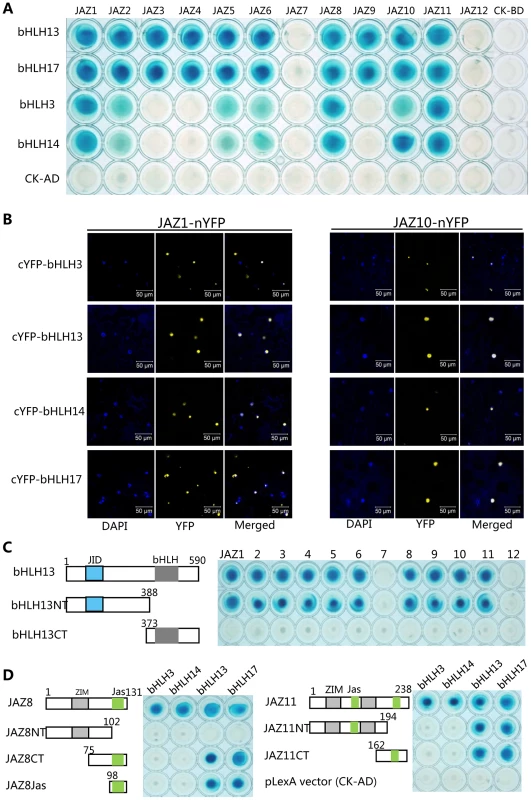
Phylogenetic analysis showed that bHLH13, together with bHLH3 (AT4G16430), bHLH14 (AT4G00870) and bHLH17 (AT2G46510/AtAIB), belongs to the subgroup IIId of the Arabidopsis bHLH family [43]–[45]. We further found that, in the yeast two-hybrid (Y2H) assays, all the bHLH subgroup IIId factors interacted with various JAZ proteins (Figure 1A).
To verify the interactions between JAZs and the bHLH3, bHLH13, bHLH14 or bHLH17 in planta, we performed bimolecular fluorescence complementation (BiFC) assays in leaves of Nicotiana benthamiana. As shown in Figure 1B, the strong signals of yellow fluorescent protein (YFP) in nucleus of N. benthamiana leaves were reconstructed by coexpression of JAZ1-nYFP (the JAZ1 fused with N-terminal fragment of YFP) with cYFP-bHLH3, cYFP-bHLH13, cYFP-bHLH14 and cYFP-bHLH17, respectively. Strong YFP signals were also detected when JAZ10 was coexpressed with these transcription factors in the BiFC assays (Figure 1B). These results suggested that these bHLH subgroup IIId factors interact with JAZs in planta.
To investigate which domain of these bHLH factors is responsible for the interaction with JAZ proteins, we representatively divided the bHLH13 into the N-terminal fragment (bHLH13NT) containing the JAZ-Interaction-Domain (JID) [40], and the C-terminal part (bHLH13CT) (Figure 1C). As shown in Figure 1C, bHLH13NT, but not bHLH13CT exhibited interactions with various JAZ proteins. Consistent with the previous speculation [40], these results suggest that the N-terminal fragment (JID domain) of the bHLH13 factor is responsible for the interactions with JAZ proteins.
To further examine which domain of JAZ proteins is critical for interactions with the bHLH subgroup IIId factors, we divided JAZ8 into the N-terminal fragment (JAZ8NT), the C-terminal part (JAZ8CT), and the Jas domain only (JAZ8Jas) (Figure 1D). Our results suggested that the Jas domain in JAZ8 is required for interactions with bHLH13 and bHLH17 (Figure 1D). Interestingly, bHLH3 and bHLH14 were able to interact with JAZ8, but not with the truncated fragments of JAZ8 (JAZ8NT, JAZ8CT and JAZ8Jas) (Figure 1D), suggesting that the entire JAZ8 is required for interactions with bHLH3 and bHLH14. Similarly, we found that the entire JAZ11 is required for interactions with bHLH3 and bHLH14, while either of Jas domains in JAZ11 is sufficient for interactions with bHLH13 and bHLH17 (Figure 1D).
The bHLH3, bHLH13, bHLH14 and bHLH17 Function Redundantly to Negatively Regulate JA Responses
To examine expression patterns of bHLH3, bHLH13, bHLH14 and bHLH17 in plant tissues, we generated Arabidopsis plants transgenic for the GUS reporter driven by endogenous promoter of each bHLH factor. Histochemical staining of the GUS activity demonstrated that all these bHLH factors are expressed in various plant tissues (Figure 2A), which is consistent with quantitative real-time PCR analysis (Figure 2B) and the public available data (www.bar.utoronto.ca) [43]. Interestingly, the COI1-dependent JA-induced gene expression was observed for bHLH13 and bHLH17, but not for bHLH3 and bHLH14 (Figure 2D). Further examination of subcellular localization indicated that bHLH3 and bHLH17 were nucleus-localized (Figure 2C), whereas bHLH13 and bHLH14 were localized in both nucleus and cytoplasm (Figure 2C).
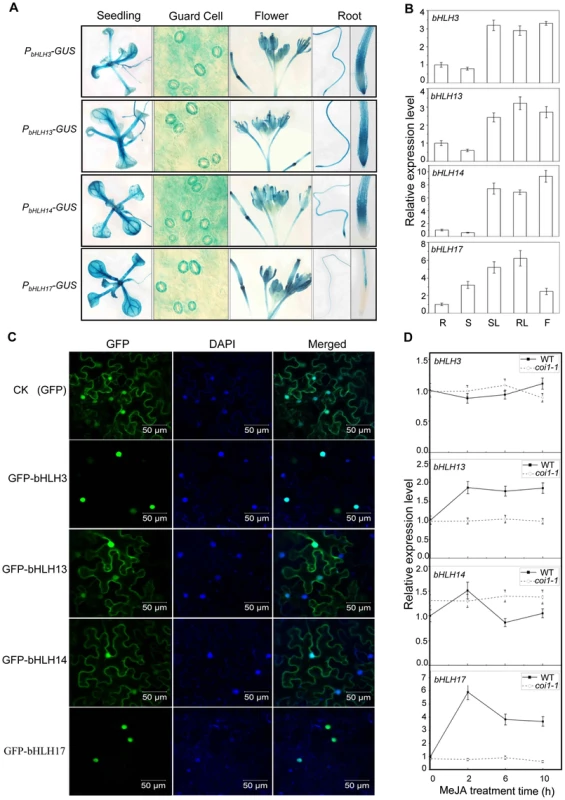
To investigate the function of the bHLH subgroup IIId factors, we identified Arabidopsis mutants for bHLH3, bHLH13, bHLH14 and bHLH17 with the T-DNA insertion into the exon (for bHLH3, bHLH14 and bHLH17) or the 5′UTR (for bHLH13) (Figure 3A). Quantitative real-time PCR analysis showed that the expression of the full length bHLH subgroup IIId gene was abolished (for bHLH3, bHLH14 and bHLH17) or obviously reduced (for bHLH13) in their respective mutants (Figures 3A and 3B). Observation of typical JA-regulated responses, including plant fertility, JA-inhibitory root growth and JA-induced anthocyanin accumulation, showed that no obvious differences were detected among wild-type, bhlh3, bhlh13, bhlh14 and bhlh17 single mutants (Figure 3, and data not shown).
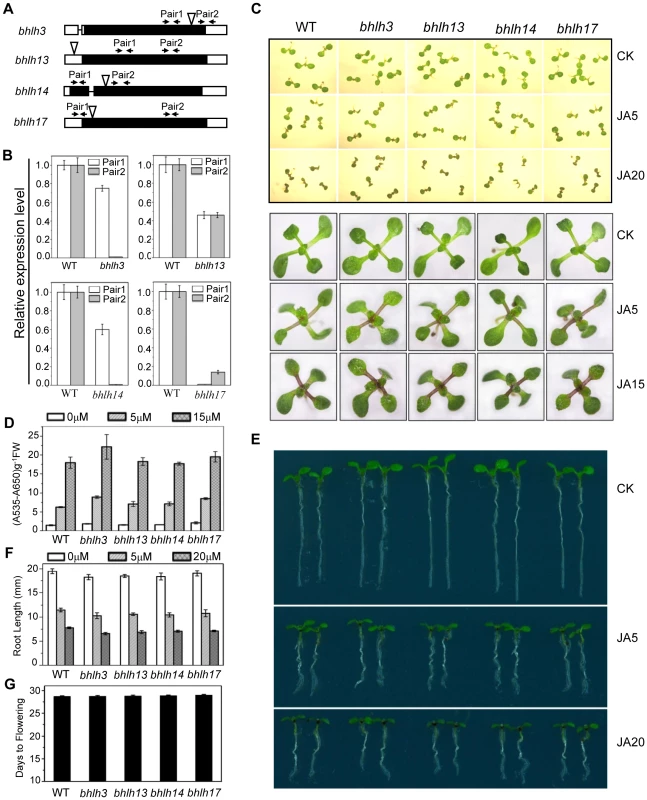
As bHLH3, bHLH13, bHLH14 and bHLH17 display high similarity at the amino acid level and belong to the same subgroup IIId of the Arabidopsis bHLH family [44], we further generated double, triple and quadruple mutants for the bHLH subgroup IIId factors, through genetic cross among the bhlh3, bhlh13, bhlh14 and bhlh17 mutants, to investigate whether these factors function redundantly in regulation of JA responses. Interestingly, we found that the anthocyanin accumulation was gradually increased in the double mutant bhlh3 bhlh17, the triple mutant bhlh3 bhlh13 bhlh17, bhlh3 bhlh13 bhlh14, bhlh3 bhlh14 bhlh17, bhlh13 bhlh14 bhlh17, and the quadruple mutant bhlh3 bhlh13 bhlh14 bhlh17 in response to MeJA treatment (Figures 4A, 4C, and S1). Consistent with the tendency of JA-induced anthocyanin accumulation (Figures 4A and 4C), MeJA-induced expression of the anthocyanin biosynthetic genes, including DFR, LDOX and UF3GT [46], was gradually increased in the double, triple and quadruple mutants (Figure 4B).
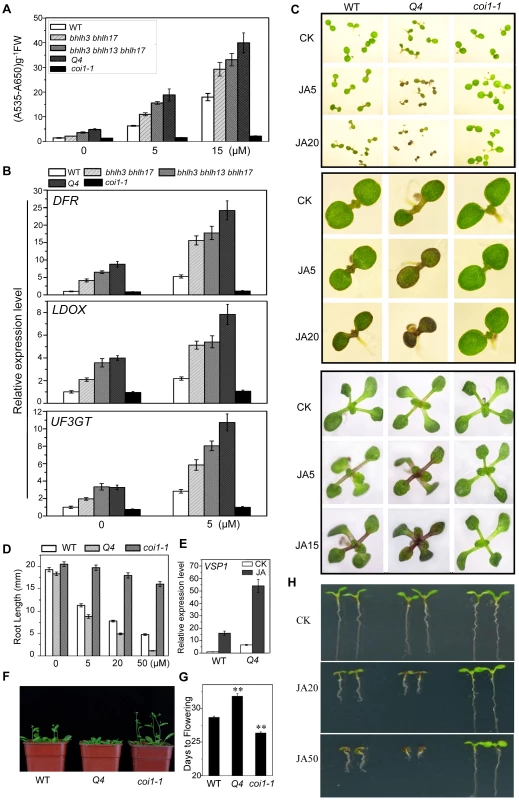
The quadruple mutant bhlh3 bhlh13 bhlh14 bhlh17 exhibited enhanced JA responses. They displayed obvious increase in JA-induced anthocyanin biosynthesis compared with wild-type control (Figures 4A and 4C). The JA-inhibitory root growth analysis also showed that the quadruple mutant was more sensitive to JA inhibition of root growth (Figures 4D and 4H). Observation of flowering time showed that the quadruple mutant also exhibited enhanced JA response: the quadruple mutant exhibited late flowering phenotype whereas the coi1-1 mutant plant flowered early (Figures 4F and 4G). Consistent with the enhanced JA-responses, expression of JA-inducible marker gene VSP1 [7] was significantly increased in the quadruple mutant (Figure 4E).
Taken together (Figures 3 and 4), mutations in bHLH3, bHLH13, bHLH14 and bHLH17 caused enhanced JA responses, demonstrating that these bHLH subgroup IIId factors function redundantly to negatively regulate JA responses.
The Quadruple Mutant bhlh3 bhlh13 bhlh14 bhlh17 Exhibited Enhanced JA-regulated Plant Defense
Botrytis cinerea, a necrotrophic fungus that causes gray mold disease in many plant species [47], induced severe wilting and high mortality in the Arabidopsis mutants coi1-1 [8], [48] or aos1[49], [50]. To investigate potential role for bHLH3, bHLH13, bHLH14 and bHLH17 in plant defense, we sprayed the B. cinerea spore suspension onto the quadruple mutant, wild-type and coi1-1 plants. As shown in Figure 5A and 5B, the quadruple mutant plants exhibited increased resistance against B. cinerea compared with wild type, whereas coi1-1 mutant plants displayed severe disease symptom, as revealed by disease severity and plant survival rate (Figures 5C and 5D). Consistent with the increased defense response, the PLANT-DEFENSIN gene PDF1.2 [51], antifungal gene THI2.1 [52], defense gene ERF1 [53] and wound-inducible gene LOX2 [54] were highly induced in the quadruple mutant compared with wild type when treated with MeJA (Figure 5E).
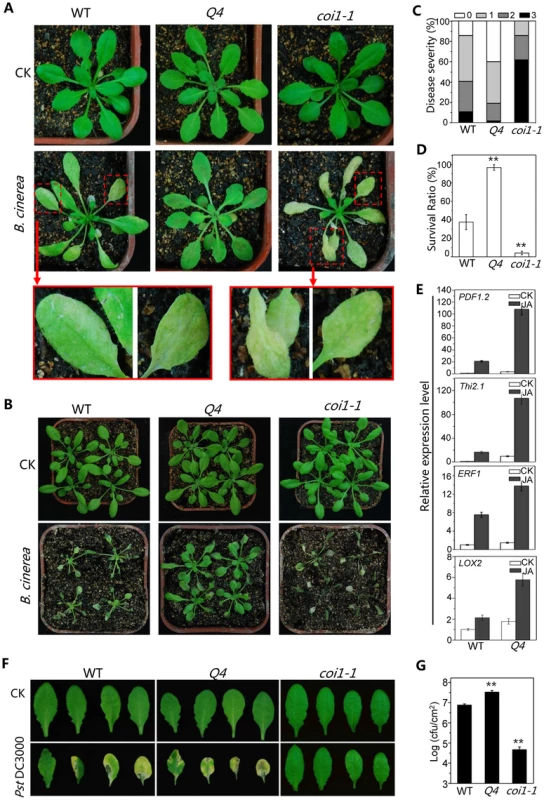
Previous studies showed that JA induces plant susceptibility to the bacterium strain Pst DC3000 of Pseudomonas syringae pv. Tomato. The coi1-1 mutant is more resistant to the Pst DC3000 inoculation [8], [55], [56] (Figures 5F and 5G). The quadruple mutant exhibited enhanced JA response in the Pst DC3000 inoculation assay: the quadruple mutant was more susceptible to the Pst DC3000 infection, whereas coi1-1 was resistant (Figures 5F and 5G).
To test whether the bHLH subgroup IIId factors regulate JA-mediated plant defense against insects, mature rosette leaves of wild-type, coi1-1, and the quadruple mutant were fed to Spodoptera exigua, a globally-significant agricultural pest with a broad host range [21]. We found that S. exigua larvae consumed the majority of the coi1-1 leaves (Figure 6A) and grew rapidly (Figures 6 B and C). However, the quadruple mutant leaves inhibited the growth of S. exigua larvae and showed reduced consumption by S. exigua (Figures 6 A–C). When insects were given the choice of selecting among wild type, coi1-1 and the quadruple mutant in the three-choice test, the quadruple mutant attracted fewer S. exigua larvae (∼6%), while wild type and coi1-1 accommodated the majority of S. exigua larvae (23% for wild type, 71% for coi1-1) (Figure 6D). In the two-choice test, the quadruple mutant attracted less larvae than wild type (∼28% for the quadruple mutant, ∼72% for wild type), while the wild-type attracted less larvae than coi1-1 (19% for wild type, ∼81% for coi1-1) (Figure 6E). These results suggested that the quadruple mutant displays enhanced JA-regulated plant defense against insect.
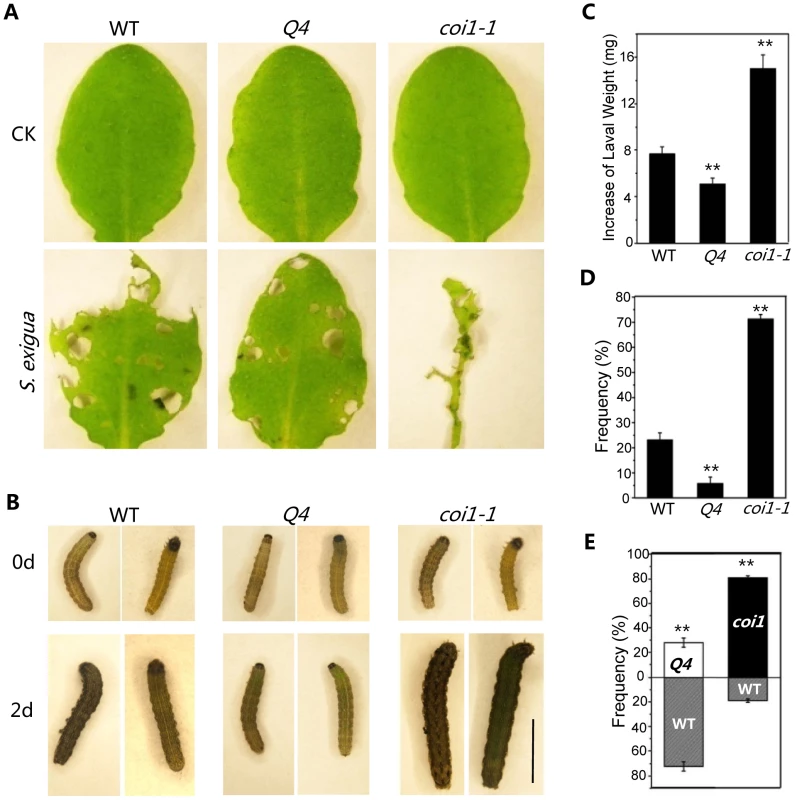
In summary, we demonstrated that the bHLH subgroup IIId factors (bHLH3, bHLH13, bHLH14 and bHLH17) function as novel negative regulators of JA-mediated plant defense.
Overexpression of the Subgroup IIId bHLH Factor Caused Reduced JA Responses
Having demonstrated that the quadruple mutant exhibited enhanced JA responses (Figures 4–6), we further investigated whether overexpression of the bHLH subgroup IIId factors would lead to reduction in JA responses. As shown in Figure 7, the bHLH17 overexpression lines, 17OE-2 and 17OE-4 with highly expressed bHLH17 transcripts (Figure 7A), exhibited reduced JA responses compared with wild type, as indicated by reduction in JA-induced anthocyanin accumulation (Figures 7B and 7C), JA-inducible anthocyanin biosynthetic gene expression (Figure 7D), and JA-inhibitory root growth (Figures 7F and 7G). Similar to the bHLH17 overexpression plants, the bHLH13 overexpression lines (13OE-3 and 13OE-7) also exhibited reduced JA responses (Figure 7). These overexpression lines also exhibited the coi1-like phenotype to flower early (Figure 7H). Consistent with the decreased JA responses, JA-inducible gene expression of VSP1, LOX2, and PDF1.2 was reduced in the bHLH13 or bHLH17 overexpression lines (Figure 7E).
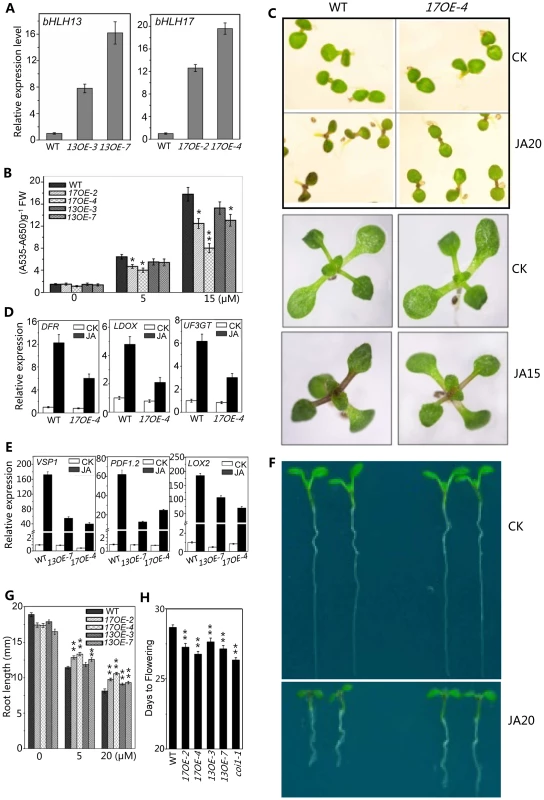
Taken together with data of the genetic and physiological analysis on the quadruple mutant and the overexpression transgenic lines (Figures 4–7), we demonstrated that the bHLH3, bHLH13, bHLH14 and bHLH17 function as novel negative regulators of JA responses.
The bHLH Subgroup IIId Factors Act as Transcription Repressors
Having shown that the bHLH subgroup IIId factors (bHLH3, bHLH13, bHLH14 and bHLH17) negatively regulat JA responses, we examined whether these bHLH subgroup IIId factors function as transcriptional repressors using the GAL4-DNA - binding-domain (GAL4DB) and its binding sites (GAL4(4X)-D1-3(4X)-GUS)-based protoplast transient expression system [57], [58]. We found that the MYC2 functions as a transcription activator whereas JAZ1 acts as a negative regulator to inhibit the MYC2 activation activity in this transient expression system (Figure 8A and 8B). In contrast, bHLH17 functions as a transcription repressor whereas JAZ1 acts as a negative regulator to inhibit the bHLH17 repression function: expression of GAL4DB-fused bHLH17 obviously repressed the activity of the GUS reporter (Figure 8A and 8B); furthermore, coexpression of JAZ1 inhibited the bHLH17 repression function and rescued the bHLH17-repressed GUS activity in a dosage-dependent manner (Figure 8B).
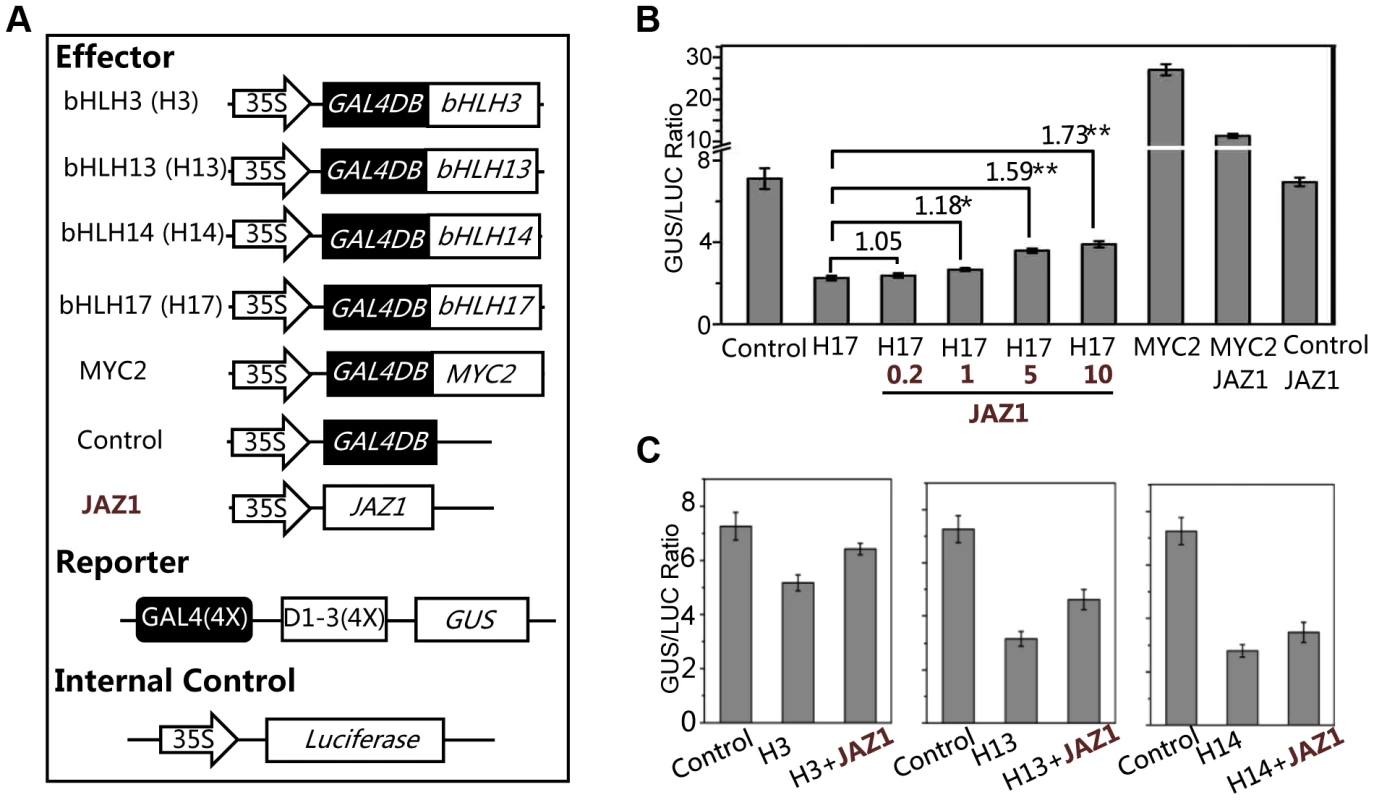
Similarly, we observed that GAL4DB-fused bHLH3, bHLH13 or bHLH14 repressed the activity of GUS reporter, and that their repression function could be partially inhibited by JAZ1 (Figure 8C). These results collectively suggest that these bHLH subgroup IIId factors act as transcriptional repressors, and that JAZ proteins interact with these transcription factors to attenuate their repression function.
The bHLH Subgroup IIId Factors Antagonize Transcription Activators in JA Pathway
We further generated a reporter construct PDFR-LUC in which the LUC reporter was driven by the promoter of DFR (Figure 9A), a direct target of the WD-repeat/TT8/MYB75 complex [46], [59], [60]. Consistent with previous data [61], [62], TT8 and MYB75 act as transcription activators to significantly induce expression of PDFR-LUC in the transient transcriptional activity assays (Figures 9A and 9B). We further found that bHLH17 repressed the TT8/MYB75-activated PDFR-LUC expression in a dosage-dependent manner (Figure 9B). Similarly, bHLH3 also repressed the TT8/MYB75-activated PDFR-LUC expression (Figure 9C).
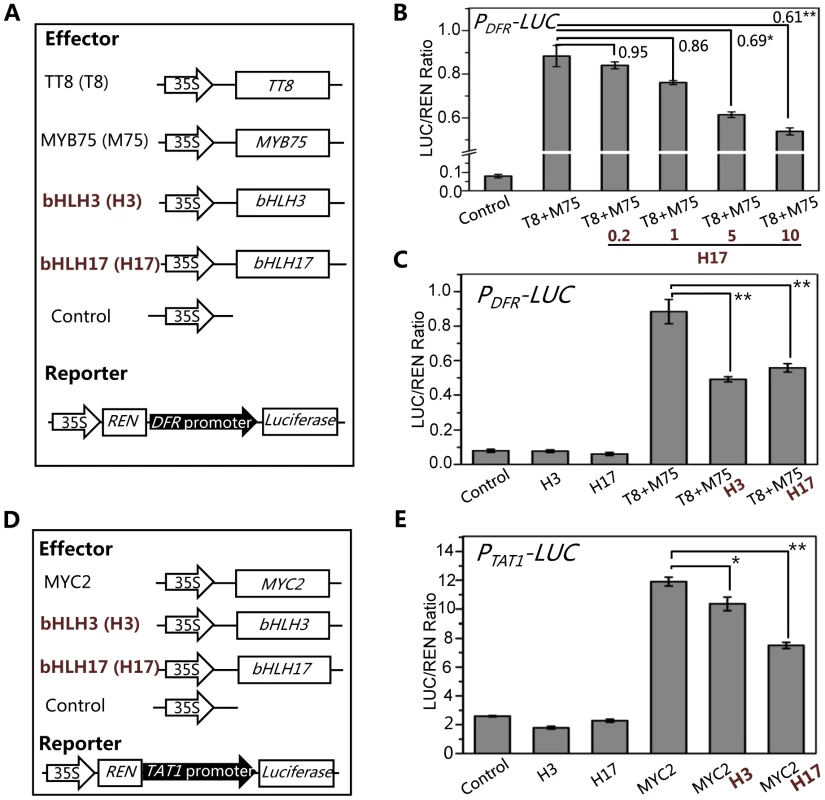
Using similar approach, we generated a reporter construct PTAT1-LUC in which the LUC reporter was driven by the promoter of TAT1 (Figure 9D), a direct target of MYC2 [63]. Consistent with previous data [63], MYC2 acts as transcription activator to significantly induce expression of PTAT1-LUC in the transient transcriptional activity assays (Figure 9E). Furthermore, we found that bHLH3 and bHLH17 were able to repress the MYC2-activated TAT1 expression (Figures 9E). These results collectively suggest that the bHLH subgroup IIId factors antagonize transcription activators (such as MYC2, TT8 and MYB75) in JA pathway.
The Y2H and BiFC assays detected no direct interactions between the transcription repressor (bHLH3, bHLH13, bHLH14 or bHLH17) and transcription activator (such as MYC2 or TT8/MYB75) (Figures S2, S3, S4), which excluded the possibility that the bHLH subgroup IIId factors antagonize the previously reported transcription activators via direct interactions. Previous studies showed the transcription activators TT8/MYB75 and MYC2 bind to and activate their respective target sequences, such as promoters of DFR and TAT1 [61]–[63]. Here we used chromatin immunoprecipitation (ChIP)-PCR assays to investigate whether the bHLH subgroup IIId factors antagonize these transcription activators through binding to their target sequences. The ChIP-PCR assays showed that DFR promoter sequence, spanning two G-box motifs (CACGTG) at the position from −182 to −154, was highly enriched in the anti-myc-immunoprecipitated chromatin of the myc-bHLH3 transgenic plant, but not in the controls (the anti-myc-pulled wild-type chromatin, the empty beads-pulled chromatin of wild-type or the myc-bHLH3 transgenic plant) (Figure 10A), demonstrating a direct binding of myc-bHLH3 to the promoter sequence of DFR. Using the similar approach, we also detected the association of myc-bHLH3 with promoter of TAT1 (Figure 10B).
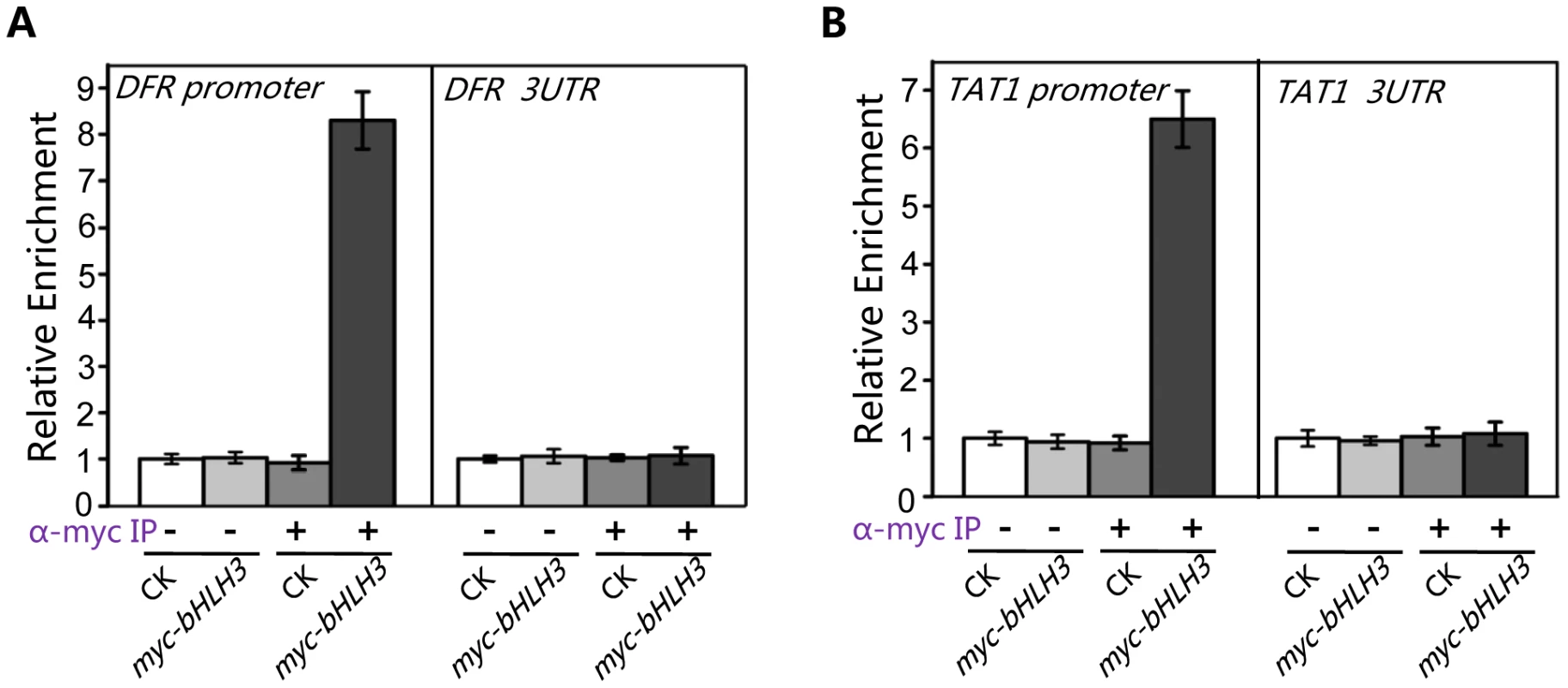
Taken together, our results suggest that bHLH3, bHLH13, bHLH14 and bHLH17 factors function as transcriptional repressors to repress the JA responses. These transcriptional repressors antagonize the previously reported transcription activators through binding to their downstream target sequences.
Discussion
The JAZ protéines [20], [29], [30], through formation of a core repression complex with TOPLESS and the NOVEL-INTERACTOR-OF-JAZ [57], are speculated to negatively regulate JA-mediated plant responses via interaction with and attenuation of their target transcription factors such as the bHLH subgroup IIIe transcription factors (MYC2, MYC3, MYC4) [29], [39]–[41], the R2R3-MYB transcription factors (MYB21, MYB24 and MYB57) [12], and the WD-repeat/bHLH (TT8, GL3 or EGL3)/MYB (MYB75 or GL1) complexes [14]. Here, we identified four bHLH subgroup IIId transcription factors (bHLH3, bHLH13, bHLH14 and bHLH17) as new targets of JAZ proteins (Figure 1). These transcription factors function as negative regulators to repress JA responses (Figures 4–7). Furthermore, our results showed that these negative regulators act as transcriptional repressors to antagonize the positive transcription factors through binding to their downstream target sequences (Figures 8–10). Coordinated regulation of JA responses by transcription repressors and transcription activators may benefit plants for adaptation to their frequently changing nature habitat.
Genetic and physiological analysis on the single, double, triple and quandruple mutants (bhlh3, bhlh13, bhlh14, bhlh17, bhlh3 bhlh17, bhlh3 bhlh13 bhlh17, bhlh3 bhlh13 bhlh14, bhlh3 bhlh14 bhlh17, bhlh13 bhlh14 bhlh17, bhlh3 bhlh13 bhlh14 bhlh17) showed that these bHLH subgroup IIId transcripiton factors function redundantly to repress JA responses (Figures 3–6 and S1). The quandruple mutant bhlh3 bhlh13 bhlh14 bhlh17 exhibited significant increase in JA responses, while the single mutant bhlh3, bhlh13, bhlh14 or bhlh17 displayed no obvious alterations in the tested JA responses (Figures 3–6 and S1), though we cannot exclude possibility that some JA responses may be mildly altered in single mutants. As shown in Figure 2 C and D, bhlh3 showed a mild increase in JA-inducible anthocyanin accumulation. Recent study also showed that the single mutant bhlh17/jam1 (another T-DNA insertion mutant of bHLH17/JAM1) displayed no obvious alteration in JA-inhibitory root growth, but exhibited the enhanced sensitivity in JA-inducible anthocyanin accumulation and defense against insect [64]. The functional redundancy among these bHLH3, bHLH13, bHLH14 and bHLH17 factors may result from their high similarity at amino acid level. It would be interesting to investigate whether and how these transcription factors exhibit homo - and heterodimerization to exert their redundant functions.
In addition to their redundant function, it is not clear whether the bHLH3, bHLH13, bHLH14 and bHLH17 factors have distinct roles in regulation of JA responses. The bHLH13 and bHLH17 exhibited similar interaction patterns with 10 JAZ proteins, and with the Jas domain of JAZ8/JAZ11 (Figure 1). However, for bHLH3 and bHLH14, they interacted with 7 JAZ proteins, and the full length of JAZ8/JAZ11 was required for interactions with bHLH3 and bHLH14 (Figure 1). Furthermore, the COI1-dependent and JA-induced gene expression was observed for bHLH13 and bHLH17, but not for bHLH3 and bHLH14 (Figure 2D). Interestingly, both bHLH3 and bHLH17 were nucleus-localized (Figure 2C), while bHLH13 and bHLH14 were localized in both nucleus and cytoplasm (Figure 2C). It remains to be elucidated whether these distinguished features would lead to distinct roles for these four transcription factors in JA pathway. Current studies so far have showed that bHLH17/AtAIB was positively involved in ABA signaling [43]. It is not clear whether the bHLH subgroup IIId factors play positive or negative roles in other signal pathways.
Previous studies showed that MYC2, and the WD-repeat/bHLH (TT8, GL3 or EGL3)/MYB (MYB75 or GL1) complexes act as transcription activators which bind to and activate promoter sequences of their respective target genes, such as TAT1 [63], and DFR [46], [60], [61]. We showed that the bHLH subgroup IIId factors act as transcription repressors (Figure 8), which bind to the promoter sequences of TAT1 and DFR (Figure 9 and 10), to antagonize the transcription function of MYC2 and MYB75/TT8 (Figure 9). It is interesting to investigate whether the bHLH subgroup IIId factors antagonize the activation function of MYC2 and MYB75/TT8 through competitive or concurrent binding to these target promoter sequences. Fernandez-Calvo et al. predicted that the activation domain is localized at the N-terminus of MYC2 [40]. It remains to experimentally investigate which domain in MYC2 (or in the bHLH subgroup IIId factors) is responsible for activation (or repression) of their target sequences.
The GAL4DB-based protoplast transient expression system is a well-established method for determination of transcription activators and repressors [57], [58], [65]–[68]. MYC2 acts as a transcription activator in this transient expression system (Figure 8A and 8B), which is consistent with previous observations [39], [57], [63], [69]. Consistent with its activation function, the MYC2 is a key gene that positively regulates a vast array of JA-responsive genes and diverse aspects of JA responses, including root growth [22], [70], anthocyanin accumulation [71], sesquiterpene synthase [72], nicotine biosynthesis [73], wound response [74], oxidative stress tolerance [75], and plant defense against both bacterial pathogen Pst DC3000 [40] and insects (Spodoptera littoralis and Helicoverpa armigera) [40], [75]. Interestingly, the MYC2 gene was shown to negatively regulate defense against necrotrophic fungi (B. cinerea and Plectosphaerella cucumerina) and expression of the related genes, such as PDF1.2 [22], [75], [76]. We showed that the bHLH subgroup IIId factors act as transcription repressors (Figures 8), which antagonize the activation function of MYC2 and TT8/MYB75 (Figure 9), to negatively regulate all the tested JA responses, including root growth, flowering, anthocyanin accumulation, and plant defense responses against bacterial pathogen Pst DC3000, necrotrophic pathogen B. cinerea, and insect S. exigua (Figures 4–7). Generation and characterization of the penta mutant myc2 bhlh3 bhlh13 bhlh14 bhlh17 would clarify whether mutations in the bHLH subgroup IIId factors are able to rescue the myc2-associated reduction of JA responses (such as root growth, anthocyanin accumulation, wound response, and defense against bacterial pathogen and insects), and to additively or synergistically affect the myc2-associated increase of defense response against necrotrophic pathogen B. cinerea.
It is speculated that, in response to JA signal, JAZ proteins are recruited by SCFCOI1 for ubiquitination and subsequent degradation. As a result, the JAZ-targeted transcription activators and repressors (bHLH3, bHLH13, bHLH14 and bHLH17) are released to antagonistically and coordinately regulate their target genes (such as TAT1 and DFR), which may further modulate expression of JA responsive genes essential for various JA responses (Figure 11). Plants live in fixed places and have to evolve sophisticated systems for adaptation to their frequently changing environment. The antagonistic and coordinated regulation of JA responses by transcription repressors and transcription activators may provide an important strategy for plant survival in their complicated nature habitat. It is possible that plants evolve this type of repressor-mediated negative regulation system to provide a fine feedback regulatory mechanism for avoiding exhausted and harmful excess JA responses.
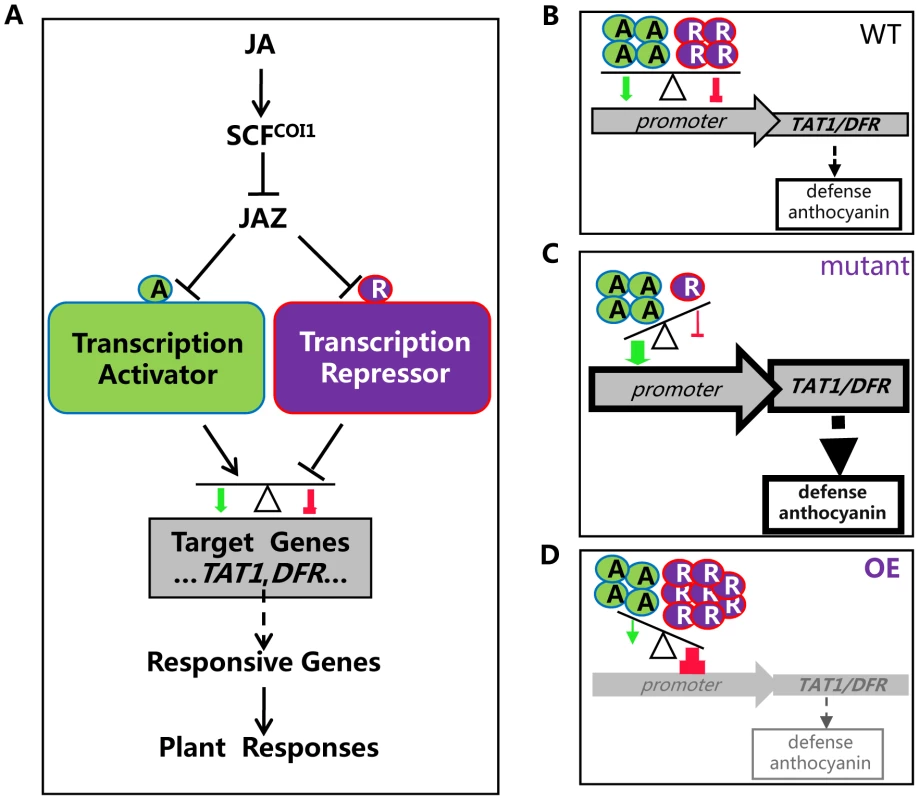
Materials and Methods
Plant Materials and Growth Conditions
The Arabidopsis thaliana mutant coi1-1 [77] was described as previously. bhlh3 (CS428877/GK-301G05), bhlh13 (CS466724/GK-696A04), bhlh14 (CS27164/GT1193.Ds3.05.24.99.b.288) and bhlh17 (CS874647/SAIL_536_F09) were obtained from the ABRC or NASC. The double, triple and quadruple mutants of the bHLH subgroup IIId factors were generated through genetic crossing among bhlh3, bhlh13, bhlh14 and bhlh17.
Arabidopsis thaliana seeds were sterilized with 20% bleach, plated on Murashige and Skoog medium (MS; Sigma-Aldrich), chilled at 4°C for 3 days, and transferred to a growth room under a 16-h (22–24°C)/8-h (16–19°C) light/dark photoperiod. Nicotiana benthamiana was grown in a growth room under a 16-h (28°C)/8-h (22°C) light/dark condition.
Y2H Screening and Y2H Assays
The yeast two-hybrid screening method was described as previously [12], [14].
For Y2H assay, all the CDS of JAZs, bHLH3, bHLH13, bHLH14, bHLH17, MYC2, MYC3, MYC4, TT8, GL3, EGL3, MYB75, GL1 and TTG1, and their domain derivatives were cloned into pLexA or pB42AD vectors. Primers used for the vector construction are presented in Table S1. The method details for yeast transformation and interaction detection using EGY48 were described as previously [12], [14]. Y2H images were taken 3 days after incubation at 30°C. Experiments were repeated three biological times.
BiFC Assays
For BiFC assays, full-length coding sequences of Arabidopsis JAZ1, JAZ10, bHLH3, bHLH13, bHLH14, bHLH17, MYC2, MYC3, MYC4, TT8, GL3, EGL3, MYB75 and GL1 were cloned into the binary nYFP or cYFP vector through enzyme digestion sites (KpnI/SalI) or Gateway reaction with pDONR207 vector system (Invitrogen) [12], [14]. Primer pairs for generation of constructs are listed in Table S1. Agrobacterium strains with indicated nYFP or cYFP vector were incubated, harvested, and resuspended in infiltration buffer (0.2 mM acetosyringone, 10 mM MgCl2, and 10 mM MES). Equal concentrations and volumes of Agrobacterium strains were mixed and coinfiltrated into N. benthamiana leaves by a needleless syringe. After infiltration, plants were placed at 24°C for 50 h before observation. The experiments were repeated three biological times.
Quantitative Real-time PCR
In Figure 2B, root, stem, rosette leaf, stem leaf and flowers were harvested for RNA extraction and subsequent reverse transcription. In Figures 2D and 7E, Arabidopsis seedlings were grown on MS medium for 11 days and then were treated with or without 100 µM MeJA for indicated time. In Figures 4B, 4E, 5E and 7D, Arabidopsis seedlings were grown on MS medium supplied with or without indicated concentration of MeJA for eleven days. These materials were harvested for RNA extraction and subsequent reverse transcription.
Real-time PCR analyses were performed with the RealMasterMix (SYBR Green I) (Takara) using the ABI7500 real-time PCR system as described previously [14]. ACTIN8 was used as the internal control. The primers used for real-time PCR analysis are presented in Table S2. All the experiments were repeated three biological times with similar results.
Protoplast Transfection Assays
For transient expression assay in Arabidopsis protoplast using the GUS reporter, the CDS of bHLH3, bHLH13, bHLH14, bHLH17 and MYC2 were fused with the GAL4DB under control of 35S promoter. The coding sequence of JAZ1 was cloned into the pGreenII 62-SK vector under control of 35S promoter [78]. Primers used for plasmid construction were shown in Table S1. Four copies of upstream GAL4 DNA binding sites (GAL4(4x)-D1-3(4x)) were used to drive the GUS gene generating the GUS reporter construct [58], [68]. The internal control contains a firefly luciferase gene (LUC) under control of 35S promoter. Arabidopsis mesophyll protoplasts preparation and subsequent transfection were performed as described previously [79]. Relative GUS activity was normalized against the LUC activity. In the JAZ1 dosage effect test of Figure 8B, 0.2, 1, 5 or 10 µg JAZ1 plasmid was respectively used, while for other reporter and effectors, 10 µg plasmid was used.
For transient transcriptional activity assay using the LUC reporter, the CDS sequences of MYC2, TT8, MYB75, bHLH3 and bHLH17 were cloned into pGreenII 62-SK vectors under control of 35S promoter respectively. The ∼519 bp and ∼980 bp promoter sequences of DFR and TAT1 were amplified from genomic DNA and cloned into pGreenII 0800-LUC respectively [78]. All primers used for making these constructs are listed in Table S1. After protoplasts preparation and subsequent transfection, firefly luciferase (LUC) and renillia luciferase (REN) activities were measured using the Dual-Luciferase Reporter Assay System (Promega) following the manufacturer's instructions. Relative firefly luciferase (LUC) activity was calculated by normalizing against the renillia luciferase activity. In the experiment of bHLH17 dosage effect in Figure 9B, 0.2, 1, 5 or 10 µg bHLH17 plasmid was respectively used, while for other reporter and effectors, 10 µg plasmid was individually used. All the experiments were repeated three biological times with similar results.
ChIP Assays
The ChIP experiment was performed as described previously [80] using leaves of the 4-week-old myc-bHLH3 transgenic plants and the wild-type (Col-0) plants treated with 100 µM MeJA for 40 minutes. Immunoprecipitation was performed using Mouse anti-MYC antibody and protein G agarose beads. Enrichment of promoter DNA was confirmed by qRT-PCR using ACTIN2 as normazlization control. Primers for 3′UTR region were used as negative control. Primers for the ChIP assays are listed in Table S2. The experiments were repeated for three biological repeats with similar results.
Generation of Transgenic Plants
To generate Arabidopsis transgenic plants overexpressing bHLH13 and bHLH17, the full-length coding sequences of bHLH13 and bHLH17 were amplified and cloned into the modified pCAMBIA1300 vector under control of 35S promoter through the SalI and SpeI sites. To generate Arabidopsis myc-bHLH3 transgenic plants, coding sequence of bHLH3 was cloned into pROK2-myc vectors for fusion with six myc tags. These constructs were introduced into Arabidopsis plants using the Agrobacterium-mediated floral dip method. Two representative transgenic lines for bHLH13 and bHLH17 respectively were displayed in the article.
GUS Staining
∼2520 bp, ∼2500 bp, ∼1050 bp and ∼2570 bp promoter regions of bHLH3, bHLH13, bHLH14 and bHLH17 were respectively amplified and cloned into pCAMBIA1391Z vector to drive the GUS genes for generation of PbHLH3-GUS, PbHLH13-GUS, PbHLH14-GUS and PbHLH17-GUS. These constructs were transformed into Agrobacterium strains GV3101, and transferred into Arabidopsis by floral dip methods. Seedlings, inflorescences and roots from the transgenic plants harboring PbHLH3-GUS, PbHLH13-GUS, PbHLH14-GUS or PbHLH17-GUS were used for histochemical staining of GUS. Histochemical staining for GUS activity assay was performed as described previously [18].
Subcellular Localization
Coding sequences of bHLH3, bHLH13, bHLH14 and bHLH17 were respectively cloned into pEGAD vector for fusion with GFP under control of 35S promoter to generate the GFP-bHLH3, GFP-bHLH13, GFP-bHLH14 and GFP-bHLH17 constructs. The Agrobacterium containing the indicated constructs were resuspended in infiltration buffer (0.2 mM acetosyringone, 10 mM MgCl2, and 10 mM MES), and infiltrated into N. benthamiana leaves by a needleless syringe. After infiltration, plants were placed at 24°C for 50 h before GFP observation.
Anthocyanin Measurement
For anthocyanin measurement, 11-d-old Arabidopsis seedlings grown on MS medium with 0, 5, or 15 µM MeJA were measured as described previously [14] The anthocyanin content is presented as (A535–A650)/g fresh weight. The experiment was repeated three biological times.
Root Length Measurement
Seeds were grown on MS medium with 0, 5, 20 or 50 µM MeJA, chilled at 4°C for 3 days, and transferred to the growth room. Root lengths of fifteen 11-d-old seedlings for each genotype and treatment were measured and presented. The experiment was repeated three biological times.
Flowering Time
Flowering time of plants, grown in soil under long day condition with 16-h(22–25°C)/8-h(18–21°C) light/dark photoperiod, was recorded as the number of days from germination to the first appearance of buds in the rosette center. The experiment was repeated three biological times.
Infection with Pathogens
For Figures 5A and 5C, thirty-day-old plants were sprayed with Botrytis cinerea (106 spores/mL) solved in 0.025% tween or with 0.025% tween as control, placed in dark at the appropriate temperature (22°C) and high humidity (100%) for 36 hours, and transferred to a growth room under the growth conditions of a 16-h-light (21 to 23°C)/8-h-dark (16 to 19°C) photoperiod with ∼40% humidity. Infection symptoms were recorded at 7-day after infection. Infection ratings from 0 to 3 were assigned to the inoculated plants (0, no visible symptoms; 1, weak symptoms; 2, severe symptoms; 3, dead plants). For Figures 5B and 5D, four-week-old plants were sprayed with Botrytis cinerea (107 spores/mL) solved in 0.025% tween or with 0.025% tween as control, placed in dark at the appropriate temperature (22°C) and high humidity (100%) for 36 hours, transferred to a growth incubator under the growth conditions of a 16-h-light (21 to 23°C)/8-h-dark (16 to 19°C) photoperiod with high humidity (>90%). Plant survival ratio were recorded at 9-day after infection. At least thirty plants from each genotype were used in each experiment. The experiment was repeated three biological times.
Thirty-day-old plants were sprayed with Pseudomonas syringae pv tomato (Pst) DC3000 suspension containing 108 (colony-forming units)/mL bacteria (OD600 = 0.2) with 0.02% Silwet L-77 or 0.02% Silwet L-77 as control. Infection symptoms were recorded at 3-day after infection. At least thirty plants from each genotype were used in each experiment. The bacterial population counts in the plant was determined as previously described [81]. The experiment was repeated three biological times.
Insect Defense Assay with Spodoptera exigua
More than fifty mature rosette leaves with similar size from 4-week-old plants for each genotype were placed in one plastic Petri dishes (90 mm) containing wet filter paper. The 10 third-instar S. exigua larvae (∼8 mg each) were weighted, and reared on leaves in one Petri dish, for each genotype using five independent replicates. Two days after feeding, the weight of the 10 larvae were measured. The increase of average larval weight was recorded.
In the two-choice test, five rosette leaves from 4-week-old plants for each genotype were placed intervally in a circle in plastic Petri dishes (90 mm) containing wet filter paper. 40 newly hatched larvae were placed in the center of the Petri dishes for equal distance to the leaves. One day after incubation in the growth room, the numbers of larvae on leaves for each genotype were recorded. Four independent replicates were performed.
In the three-choice test, three rosette leaves from 4-week-old plants for each genotype were placed intervally in a circle in plastic Petri dishes (90 mm) containing wet filter paper. 40 newly hatched larvae were placed in the center of the Petri dishes for equal distance to the leaves. One day after incubation in the growth room, the numbers of larvae on leaves for each genotype were recorded. Six independent replicates were performed.
Accession Numbers
The Arabidopsis Genome Initiative numbers for genes mentioned in this article are as follows: JAZ1 (AT1G19180), JAZ2 (AT1G74950), JAZ3 (AT3G17860), JAZ4 (AT1G48500), JAZ5 (AT1G17380), JAZ6 (AT1G72450), JAZ7 (AT2G34600), JAZ8 (AT1G30135), JAZ9 (AT1G70700), JAZ10 (AT5G13220), JAZ11 (AT3G43440), JAZ12 (AT5G20900), bHLH3 (AT4G16430), bHLH13 (AT1G01260), bHLH14 (AT4G00870), bHLH17 (AT2G46510), MYC2 (AT1G32640), MYC3 (AT5G46760), MYC4 (AT4G17880), TT8 (AT4G09820), GL3 (AT5G41315), EGL3 (AT1G63650), MYB75 (AT1G56650), GL1 (AT3G27920), TTG1 (AT5G24520), DFR (AT5G42800), LDOX (AT4G22880), UF3GT (AT5G54060), VSP1 (AT5G24780), THI2.1 (AT1G72260), PDF1.2 (AT5G44420), LOX2 (AT3G45140), TAT1 (AT4G23600), ERF1 (AT3G23240) and ACTIN8 (AT1G49240).
Supporting Information
Zdroje
1. VanstraelenM, BenkovaE (2012) Hormonal interactions in the regulation of plant development. Annu Rev Cell Dev Biol 28 : 463–487.
2. JonesJD, DanglJL (2006) The plant immune system. Nature 444 : 323–329.
3. SpoelSH, DongX (2008) Making sense of hormone crosstalk during plant immune responses. Cell Host Microbe 3 : 348–351.
4. SchallerA, StintziA (2009) Enzymes in jasmonate biosynthesis - structure, function, regulation. Phytochemistry 70 : 1532–1538.
5. WasternackC, HauseB (2013) Jasmonates: biosynthesis, perception, signal transduction and action in plant stress response, growth and development. An update to the 2007 review in Annals of Botany. Ann Bot
6. CreelmanRA, MulletJE (1997) Biosynthesis and action of jasmonates in plants. Annu Rev Plant Physiol Plant Mol Biol 48 : 355–381.
7. StaswickPE, SuWP, HowellSH (1992) Methyl jasmonate inhibition of root-growth and induction of a leaf protein are decreased in an Arabidopsis thaliana Mutant. Proc Natl Acad Sci USA 89 : 6837–6840.
8. FeysBJF, BenedettiCE, PenfoldCN, TurnerJG (1994) Arabidopsis mutants selected for resistance to the phytotoxin coronatine are male-sterile, insensitive to methyl jasmonate, and resistant to a bacterial pathogen. Plant Cell 6 : 751–759.
9. SunJ, XuY, YeS, JiangH, ChenQ, et al. (2009) Arabidopsis ASA1 is important for jasmonate-mediated regulation of auxin biosynthesis and transport during lateral root formation. Plant Cell 21 : 1495–1511.
10. ChenQ, SunJ, ZhaiQ, ZhouW, QiL, et al. (2011) The basic helix-loop-helix transcription factor MYC2 directly represses PLETHORA expression during jasmonate-mediated modulation of the root stem cell niche in Arabidopsis. Plant Cell 23 : 3335–3352.
11. McConnM, BrowseJ (1996) The critical requirement for linolenic acid is pollen development, not photosynthesis, in an Arabidopsis mutant. Plant Cell 8 : 403–416.
12. SongS, QiT, HuangH, RenQ, WuD, et al. (2011) The Jasmonate-ZIM Domain Proteins Interact with the R2R3-MYB Transcription Factors MYB21 and MYB24 to Affect Jasmonate-Regulated Stamen Development in Arabidopsis. Plant Cell 23 : 1000–1013.
13. LiL, ZhaoY, McCaigBC, WingerdBA, WangJ, et al. (2004) The tomato homolog of CORONATINE-INSENSITIVE1 is required for the maternal control of seed maturation, jasmonate-signaled defense responses, and glandular trichome development. Plant Cell 16 : 126–143.
14. QiT, SongS, RenQ, WuD, HuangH, et al. (2011) The Jasmonate-ZIM-Domain Proteins Interact with the WD-Repeat/bHLH/MYB Complexes to Regulate Jasmonate-Mediated Anthocyanin Accumulation and Trichome Initiation in Arabidopsis thaliana. Plant Cell 23 : 1795–1814.
15. YoshidaY, SanoR, WadaT, TakabayashiJ, OkadaK (2009) Jasmonic acid control of GLABRA3 links inducible defense and trichome patterning in Arabidopsis. Development 136 : 1039–1048.
16. LackmanP, Gonzalez-GuzmanM, TillemanS, CarqueijeiroI, PerezAC, et al. (2011) Jasmonate signaling involves the abscisic acid receptor PYL4 to regulate metabolic reprogramming in Arabidopsis and tobacco. Proc Natl Acad Sci U S A 108 : 5891–5896.
17. YanJ, LiH, LiS, YaoR, DengH, et al. (2013) The Arabidopsis F-Box Protein CORONATINE INSENSITIVE1 Is Stabilized by SCFCOI1 and Degraded via the 26S Proteasome Pathway. Plant Cell doi:10.1105/tpc.112.105486.
18. ShanX, WangJ, ChuaL, JiangD, PengW, et al. (2011) A role of Arabidopsis Rubisco activase in jasmonate-induced leaf senescence. Plant Physiol 155 : 751–764.
19. RobsonF, OkamotoH, PatrickE, HarrisSR, WasternackC, et al. (2010) Jasmonate and phytochrome A signaling in Arabidopsis wound and shade responses are integrated through JAZ1 stability. Plant Cell 22 : 1143–1160.
20. YanYX, StolzS, ChetelatA, ReymondP, PagniM, et al. (2007) A downstream mediator in the growth repression limb of the jasmonate pathway. Plant Cell 19 : 2470–2483.
21. HoweGA, JanderG (2008) Plant immunity to insect herbivores. Annu Rev Plant Biol 59 : 41–66.
22. LorenzoO, ChicoJM, Sanchez-SerranoJJ, SolanoR (2004) JASMONATE-INSENSITIVE1 encodes a MYC transcription factor essential to discriminate between different jasmonate-regulated defense responses in Arabidopsis. Plant Cell 16 : 1938–1950.
23. ThalerJS, HumphreyPT, WhitemanNK (2012) Evolution of jasmonate and salicylate signal crosstalk. Trends Plant Sci 17 : 260–270.
24. HuP, ZhouW, ChengZ, FanM, WangL, et al. (2013) JAV1 Controls Jasmonate-Regulated Plant Defense. Mol Cell 50 : 504–515.
25. WathugalaDL, HemsleyPA, MoffatCS, CremelieP, KnightMR, et al. (2012) The Mediator subunit SFR6/MED16 controls defence gene expression mediated by salicylic acid and jasmonate responsive pathways. New Phytol 195 : 217–230.
26. SeoJS, JooJ, KimMJ, KimYK, NahmBH, et al. (2011) OsbHLH148, a basic helix-loop-helix protein, interacts with OsJAZ proteins in a jasmonate signaling pathway leading to drought tolerance in rice. Plant J 65 : 907–921.
27. YanJ, ZhangC, GuM, BaiZ, ZhangW, et al. (2009) The Arabidopsis CORONATINE INSENSITIVE1 protein is a jasmonate receptor. Plant Cell 21 : 2220–2236.
28. FonsecaS, ChiniA, HambergM, AdieB, PorzelA, et al. (2009) (+)-7-iso-Jasmonoyl-L-isoleucine is the endogenous bioactive jasmonate. Nature Chemical Biology 5 : 344–350.
29. ChiniA, FonsecaS, FernandezG, AdieB, ChicoJM, et al. (2007) The JAZ family of repressors is the missing link in jasmonate signalling. Nature 448 : 666–671.
30. ThinesB, KatsirL, MelottoM, NiuY, MandaokarA, et al. (2007) JAZ repressor proteins are targets of the SCF(COI1) complex during jasmonate signalling. Nature 448 : 661–665.
31. KatsirL, SchilmillerAL, StaswickPE, HeSY, HoweGA (2008) COI1 is a critical component of a receptor for jasmonate and the bacterial virulence factor coronatine. Proc Natl Acad Sci USA 105 : 7100–7105.
32. SheardLB, TanX, MaoH, WithersJ, Ben-NissanG, et al. (2010) Jasmonate perception by inositol-phosphate-potentiated COI1-JAZ co-receptor. Nature 468 : 400–405.
33. BrowseJ (2009) Jasmonate passes muster: a receptor and targets for the defense hormone. Annu Rev Plant Biol 60 : 183–205.
34. SantnerA, EstelleM (2007) The JAZ proteins link jasmonate perception with transcriptional changes. Plant Cell 19 : 3839–3842.
35. KazanK, MannersJM (2012) JAZ repressors and the orchestration of phytohormone crosstalk. Trends Plant Sci 17 : 22–31.
36. PauwelsL, GoossensA (2011) The JAZ proteins: a crucial interface in the jasmonate signaling cascade. Plant Cell 23 : 3089–3100.
37. De GeyterN, GholamiA, GoormachtigS, GoossensA (2012) Transcriptional machineries in jasmonate-elicited plant secondary metabolism. Trends Plant Sci 17 : 349–359.
38. ShanX, YanJ, XieD (2012) Comparison of phytohormone signaling mechanisms. Curr Opin Plant Biol 15 : 84–91.
39. NiuY, FigueroaP, BrowseJ (2011) Characterization of JAZ-interacting bHLH transcription factors that regulate jasmonate responses in Arabidopsis. J Exp Bot 62 : 2143–2154.
40. Fernandez-CalvoP, ChiniA, Fernandez-BarberoG, ChicoJM, Gimenez-IbanezS, et al. (2011) The Arabidopsis bHLH Transcription Factors MYC3 and MYC4 Are Targets of JAZ Repressors and Act Additively with MYC2 in the Activation of Jasmonate Responses. Plant Cell 23 : 701–715.
41. ChengZ, SunL, QiT, ZhangB, PengW, et al. (2011) The bHLH Transcription Factor MYC3 Interacts with the Jasmonate ZIM-Domain Proteins to Mediate Jasmonate Response in Arabidopsis. Mol Plant 4 : 279–288.
42. ChengH, SongS, XiaoL, SooHM, ChengZ, et al. (2009) Gibberellin acts through jasmonate to control the expression of MYB21, MYB24, and MYB57 to promote stamen filament growth in Arabidopsis. PLoS Genet 5: e1000440.
43. LiH, SunJ, XuY, JiangH, WuX, et al. (2007) The bHLH-type transcription factor AtAIB positively regulates ABA response in Arabidopsis. Plant Mol Biol 65 : 655–665.
44. HeimMA, JakobyM, WerberM, MartinC, WeisshaarB, et al. (2003) The basic helix-loop-helix transcription factor family in plants: a genome-wide study of protein structure and functional diversity. Mol Biol Evol 20 : 735–747.
45. Toledo-OrtizG, HuqE, QuailPH (2003) The Arabidopsis basic/helix-loop-helix transcription factor family. Plant Cell 15 : 1749–1770.
46. GonzalezA, ZhaoM, LeavittJM, LloydAM (2008) Regulation of the anthocyanin biosynthetic pathway by the TTG1/bHLH/Myb transcriptional complex in Arabidopsis seedlings. Plant J 53 : 814–827.
47. GlazebrookJ (2005) Contrasting mechanisms of defense against biotrophic and necrotrophic pathogens. Annu Rev Phytopathol 43 : 205–227.
48. ThommaBP, EggermontK, PenninckxIA, Mauch-ManiB, VogelsangR, et al. (1998) Separate jasmonate-dependent and salicylate-dependent defense-response pathways in Arabidopsis are essential for resistance to distinct microbial pathogens. Proc Natl Acad Sci U S A 95 : 15107–15111.
49. Mene-SaffraneL, DubugnonL, ChetelatA, StolzS, Gouhier-DarimontC, et al. (2009) Nonenzymatic oxidation of trienoic fatty acids contributes to reactive oxygen species management in Arabidopsis. J Biol Chem 284 : 1702–1708.
50. ParkJH, HalitschkeR, KimHB, BaldwinIT, FeldmannKA, et al. (2002) A knock-out mutation in allene oxide synthase results in male sterility and defective wound signal transduction in Arabidopsis due to a block in jasmonic acid biosynthesis. Plant J 31 : 1–12.
51. PenninckxIA, EggermontK, TerrasFR, ThommaBP, De SamblanxGW, et al. (1996) Pathogen-induced systemic activation of a plant defensin gene in Arabidopsis follows a salicylic acid-independent pathway. Plant Cell 8 : 2309–2323.
52. EppleP, ApelK, BohlmannH (1997) ESTs reveal a multigene family for plant defensins in Arabidopsis thaliana. FEBS Lett 400 : 168–172.
53. Berrocal-LoboM, MolinaA, SolanoR (2002) Constitutive expression of ETHYLENE-RESPONSE-FACTOR1 in Arabidopsis confers resistance to several necrotrophic fungi. Plant J 29 : 23–32.
54. MasonHS, DeWaldDB, MulletJE (1993) Identification of a methyl jasmonate-responsive domain in the soybean vspB promoter. Plant Cell 5 : 241–251.
55. MelottoM, UnderwoodW, KoczanJ, NomuraK, HeSY (2006) Plant stomata function in innate immunity against bacterial invasion. Cell 126 : 969–980.
56. YangDL, YaoJ, MeiCS, TongXH, ZengLJ, et al. (2012) Plant hormone jasmonate prioritizes defense over growth by interfering with gibberellin signaling cascade. Proc Natl Acad Sci U S A 109: E1192–1200.
57. PauwelsL, BarberoGF, GeerinckJ, TillemanS, GrunewaldW, et al. (2010) NINJA connects the co-repressor TOPLESS to jasmonate signalling. Nature 464 : 788–791.
58. TiwariSB, WangXJ, HagenG, GuilfoyleTJ (2001) AUX/IAA proteins are active repressors, and their stability and activity are modulated by auxin. Plant Cell 13 : 2809–2822.
59. NesiN, DebeaujonI, JondC, PelletierG, CabocheM, et al. (2000) The TT8 gene encodes a basic helix-loop-helix domain protein required for expression of DFR and BAN genes in Arabidopsis siliques. Plant Cell 12 : 1863–1878.
60. ZhangF, GonzalezA, ZhaoM, PayneCT, LloydA (2003) A network of redundant bHLH proteins functions in all TTG1-dependent pathways of Arabidopsis. Development 130 : 4859–4869.
61. MatsuiK, UmemuraY, Ohme-TakagiM (2008) AtMYBL2, a protein with a single MYB domain, acts as a negative regulator of anthocyanin biosynthesis in Arabidopsis. Plant J 55 : 954–967.
62. ZimmermannIM, HeimMA, WeisshaarB, UhrigJF (2004) Comprehensive identification of Arabidopsis thaliana MYB transcription factors interacting with R/B-like BHLH proteins. Plant J 40 : 22–34.
63. HouX, LeeLY, XiaK, YanY, YuH (2010) DELLAs modulate jasmonate signaling via competitive binding to JAZs. Dev Cell 19 : 884–894.
64. NakataM, MitsudaN, HerdeM, KooAJ, MorenoJE, et al. (2013) A bHLH-Type Transcription Factor, ABA-INDUCIBLE BHLH-TYPE TRANSCRIPTION FACTOR/JA-ASSOCIATED MYC2-LIKE1, Acts as a Repressor to Negatively Regulate Jasmonate Signaling in Arabidopsis. Plant Cell In Press: tpc.113.111112.
65. OhtaM, Ohme-TakagiM, ShinshiH (2000) Three ethylene-responsive transcription factors in tobacco with distinct transactivation functions. Plant J 22 : 29–38.
66. GuoS, XuY, LiuH, MaoZ, ZhangC, et al. (2013) The interaction between OsMADS57 and OsTB1 modulates rice tillering via DWARF14. Nat Commun 4 : 1566.
67. TaoQ, GuoD, WeiB, ZhangF, PangC, et al. (2013) The TIE1 transcriptional repressor links TCP transcription factors with TOPLESS/TOPLESS-RELATED corepressors and modulates leaf development in Arabidopsis. Plant Cell 25 : 421–437.
68. ZhuJ, JeongJC, ZhuY, SokolchikI, MiyazakiS, et al. (2008) Involvement of Arabidopsis HOS15 in histone deacetylation and cold tolerance. Proc Natl Acad Sci U S A 105 : 4945–4950.
69. AbeH, Yamaguchi-ShinozakiK, UraoT, IwasakiT, HosokawaD, et al. (1997) Role of arabidopsis MYC and MYB homologs in drought - and abscisic acid-regulated gene expression. Plant Cell 9 : 1859–1868.
70. BoterM, Ruiz-RiveroO, AbdeenA, PratS (2004) Conserved MYC transcription factors play a key role in jasmonate signaling both in tomato and Arabidopsis. Genes Dev 18 : 1577–1591.
71. Laurie-BerryN, JoardarV, StreetIH, KunkelBN (2006) The Arabidopsis thaliana JASMONATE INSENSITIVE 1 gene is required for suppression of salicylic acid-dependent defenses during infection by Pseudomonas syringae. Molecular Plant-Microbe Interactions 19 : 789–800.
72. HongGJ, XueXY, MaoYB, WangLJ, ChenXY (2012) Arabidopsis MYC2 interacts with DELLA proteins in regulating sesquiterpene synthase gene expression. Plant Cell 24 : 2635–2648.
73. ShojiT, HashimotoT (2011) Tobacco MYC2 regulates jasmonate-inducible nicotine biosynthesis genes directly and by way of the NIC2-locus ERF genes. Plant Cell Physiol 52 : 1117–1130.
74. ZhangY, TurnerJG (2008) Wound-induced endogenous jasmonates stunt plant growth by inhibiting mitosis. PLoS One 3: e3699.
75. DombrechtB, XueGP, SpragueSJ, KirkegaardJA, RossJJ, et al. (2007) MYC2 differentially modulates diverse jasmonate-dependent functions in Arabidopsis. Plant Cell 19 : 2225–2245.
76. ZhaiQ, YanL, TanD, ChenR, SunJ, et al. (2013) Phosphorylation-Coupled Proteolysis of the Transcription Factor MYC2 Is Important for Jasmonate-Signaled Plant Immunity. PLoS Genet 9: e1003422.
77. XieDX, FeysBF, JamesS, Nieto-RostroM, TurnerJG (1998) COI1: An Arabidopsis gene required for jasmonate-regulated defense and fertility. Science 280 : 1091–1094.
78. HellensRP, AllanAC, FrielEN, BolithoK, GraftonK, et al. (2005) Transient expression vectors for functional genomics, quantification of promoter activity and RNA silencing in plants. Plant Methods 1 : 13.
79. YooSD, ChoYH, SheenJ (2007) Arabidopsis mesophyll protoplasts: a versatile cell system for transient gene expression analysis. Nat Protoc 2 : 1565–1572.
80. SalehA, Alvarez-VenegasR, AvramovaZ (2008) An efficient chromatin immunoprecipitation (ChIP) protocol for studying histone modifications in Arabidopsis plants. Nat Protoc 3 : 1018–1025.
81. KatagiriF, ThilmonyR, HeSY (2002) The Arabidopsis thaliana-pseudomonas syringae interaction. Arabidopsis Book 1: e0039.
Štítky
Genetika Reprodukční medicínaČlánek vyšel v časopise
PLOS Genetics
2013 Číslo 7
- Růst a vývoj dětí narozených pomocí IVF
- Souvislost haplotypu M2 genu pro annexin A5 s opakovanými reprodukčními ztrátami
- Transthyretinová amyloidóza z pohledu neurologa a kardiologa aneb jak se vyhnout „misdiagnostice“?
- Velké děti po kryoembryotransferu
- Doc. Eva Vlčková: Transthyretinová amyloidóza již díky moderní terapii nemusí být fatální diagnózou, musíme ji však zachytit a léčit včas
Nejčtenější v tomto čísle
- The Cohesion Protein SOLO Associates with SMC1 and Is Required for Synapsis, Recombination, Homolog Bias and Cohesion and Pairing of Centromeres in Drosophila Meiosis
- Gene × Physical Activity Interactions in Obesity: Combined Analysis of 111,421 Individuals of European Ancestry
- Independent Evolution of Transcriptional Inactivation on Sex Chromosomes in Birds and Mammals
- SLC26A4 Targeted to the Endolymphatic Sac Rescues Hearing and Balance in Mutant Mice

